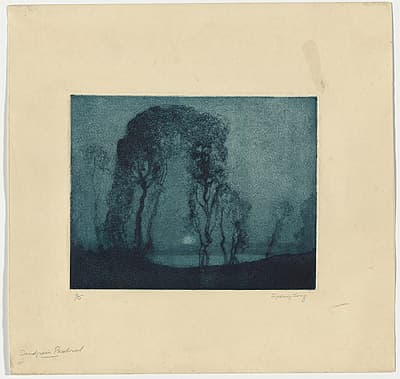
Sydney
LONG
Australia
1871
–
London
1955
England, Europe 1910-21; Australia 1921- 22; England 1922-25; Australia 1925-52; England from 1952
13.9 (h) x 17.6 (w) cm
1/15 , published state , edition of 15 , no manufacturer's mark
Signed lower right below plate-mark in black pencil, 'Sydney Long'. Not dated. Titled lower left corner of sheet in black pencil, 'Sandgrain Pastoral ['ain P' underlined]'.
Reference: Mendelssohn (1979), 12; Paul (1928), 38 National Gallery of Australia, Canberra NGA 1965.134 The Oscar Paul Collection, Gift of Henriette von Dallwitz and of Richard Paul in honour of his father 1965. Reproduced with the kind permission of the Ophthalmic Research Institute of Australia
- The Oscar Paul Collection.
- Bequest to the Commonwealth Art Advisory Board (C.A.A.B.), from Mrs Henriette von Dallwitz legatee of Richard Paul after reinbursement to estate, to fulfill Richard Paul's intentions to honour his father, May 1965.
'With its delicate romantic charm’ Pastoral sandgrain was ‘a decided success’ (Paul 1928, p 3). Long based this image on a pencil sketch he made at Woy Woy, on the southern reaches of Brisbane Water, some time previously. But, it is less a depiction of place than an atmospheric image capturing the poetry of twilight, with Long rendering his subject in purely tonal relationships.
Long’s use of sandgrain was innovative. The plate was grounded with ordinary etching wax and smoked, then a piece of emery paper of the required texture was placed face downwards on this ground and the plate then passed through a printing press, causing the grain of the emery paper to penetrate the wax through to the copper. The design was drawn on this surface and the plate bitten in the usual way (Paul 1928, p 8).
This print is possiby Long’s first plate, made while a student at the Central School of Arts and Crafts, London. He first exhibited a copy of this print in 1921 in The water-colours and etchings of Sydney Long, ARE, Decoration Galleries, Melbourne, 15–26 August (4, as ‘Nocturne (Sandgrain)’). Dorothy Ellsmore Paul’s dating of 1916 is now known to be incorrect as Long did not start printmaking until 1918. We have dated it 1918 on the basis of it being one of Long’s earliest prints, made while he was at the Central School. The National Gallery of Australia holds another copy, in black ink. Copies are held by the Art Gallery of New South Wales, the National Gallery of Victoria and the Tasmanian Museum and Art Gallery. Another copy was presented to the Victoria & Albert Museum, London, in 1921 by William P. Robins.
'With its delicate romantic charm’ Pastoral sandgrain was ‘a decided success’ (Paul 1928, p 3). Long based this image on a pencil sketch he made at Woy Woy, on the southern reaches of Brisbane Water, some time previously. But, it is less a depiction of place than an atmospheric image capturing the poetry of twilight, with Long rendering his subject in purely tonal relationships.
Long’s use of sandgrain was innovative. The plate was grounded with ordinary etching wax and smoked, then a piece of emery paper of the required texture was placed face downwards on this ground and the plate then passed through a printing press, causing the grain of the emery paper to penetrate the wax through to the copper. The design was drawn on this surface and the plate bitten in the usual way (Paul 1928, p 8).
This print is possiby Long’s first plate, made while a student at the Central School of Arts and Crafts, London. He first exhibited a copy of this print in 1921 in The water-colours and etchings of Sydney Long, ARE, Decoration Galleries, Melbourne, 15–26 August (4, as ‘Nocturne (Sandgrain)’). Dorothy Ellsmore Paul’s dating of 1916 is now known to be incorrect as Long did not start printmaking until 1918. We have dated it 1918 on the basis of it being one of Long’s earliest prints, made while he was at the Central School. The National Gallery of Australia holds another copy, in black ink. Copies are held by the Art Gallery of New South Wales, the National Gallery of Victoria and the Tasmanian Museum and Art Gallery. Another copy was presented to the Victoria & Albert Museum, London, in 1921 by William P. Robins.
'With its delicate romantic charm’ Pastoral sandgrain was ‘a decided success’ (Paul 1928, p 3). Long based this image on a pencil sketch he made at Woy Woy, on the southern reaches of Brisbane Water, some time previously. But, it is less a depiction of place than an atmospheric image capturing the poetry of twilight, with Long rendering his subject in purely tonal relationships.
Long’s use of sandgrain was innovative. The plate was grounded with ordinary etching wax and smoked, then a piece of emery paper of the required texture was placed face downwards on this ground and the plate then passed through a printing press, causing the grain of the emery paper to penetrate the wax through to the copper. The design was drawn on this surface and the plate bitten in the usual way (Paul 1928, p 8).
This print is possiby Long’s first plate, made while a student at the Central School of Arts and Crafts, London. He first exhibited a copy of this print in 1921 in The water-colours and etchings of Sydney Long, ARE, Decoration Galleries, Melbourne, 15–26 August (4, as ‘Nocturne (Sandgrain)’). Dorothy Ellsmore Paul’s dating of 1916 is now known to be incorrect as Long did not start printmaking until 1918. We have dated it 1918 on the basis of it being one of Long’s earliest prints, made while he was at the Central School. The National Gallery of Australia holds another copy, in black ink. Copies are held by the Art Gallery of New South Wales, the National Gallery of Victoria and the Tasmanian Museum and Art Gallery. Another copy was presented to the Victoria & Albert Museum, London, in 1921 by William P. Robins.
